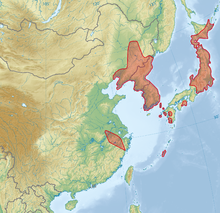Great East Asian noctule bat
| Great East Asian noctule bat | ||||||||||||
|---|---|---|---|---|---|---|---|---|---|---|---|---|
| Systematics | ||||||||||||
|
||||||||||||
| Scientific name | ||||||||||||
| Nyctalus aviator | ||||||||||||
| ( Thomas , 1911) |
The great East Asian noctule bat ( Nyctalus aviator ) is a bat species from the genus of the noctule bat within the smooth-nosed bat (Vespertilionidae). It is spread over parts of the People's Republic of China , Japan , Korea and probably also Russia .
features
The great East Asian noctule bat is a large species of bat with a head-to-trunk length of 8.0 to 10.6 centimeters with a tail 4.5 to 6.2 centimeters in length. The forearm reaches a length of 5.8 to 6.4 centimeters, the rear foot is 1.2 to 1.7 centimeters long and the ear 1.6 to 2.3 centimeters. The fur is dense and colored yellow-brown.
The skin of the animals reaches to the heel and is attached there, the calcar is keeled and the tail extends slightly out of the skin of the tail. The thumb is short with a pronounced, long claw. Of the fingers, the fifth finger is the shortest and the third the longest.
The skull is broad and strong, the muzzle is broad with glands between the eyes and the nostrils. The tragus in the ear is short and blunt, the antitragus long and flat. Characteristic features of the species mainly affect the teeth, so the upper inner incisor is longer than the outer. Overall, the teeth are large with flat crowns.
distribution
The Palearctic distribution area of the great East Asian noctule includes parts of the eastern People's Republic of China , Japan , Korea and probably Russia .
In China, the species lives in Heilongjiang , Jilin , Henan , Zhejiang, and Anhui provinces . In Japan it is native to the islands of Hokkaidō , Honshū , Shikoku , Kyushu , Iki , Fukue , Okinawa and Tsushima . Individual sightings and echo locations have been documented in eastern Russia, but no data are available on a potential spread.
Way of life
The great East Asian noctule bat lives in wooded areas and looks for resting places in tree hollows and in the foliage of trees. The species is nocturnal and feeds mainly on insects. As with the Giant Noctule ( Nyctalus lasiopterus ) and the Ia io , however, it has also been proven for the Great East Asian Noctule in Japan that it regularly preyes on birds and feeds on them. For example, remains of birds, especially feathers and bones of songbirds , were found in fecal samples in spring, autumn and winter in various parts of Japan.
Systematics
|
Phylogenetic system of the genus Nyctalus
|
The Great East Asia Noctule is currently one of the eight species within the Noctule ( Nyctalus ), in its circulation area also that of the noctule ( Nyctalus noctula ) and the Chinese Noctule ( Nyctalus plancyi ) occur. The great noctule bat was originally considered a subspecies of the great noctule bat ( Nyctalus lasiopterus ).
According to a study by Salgueiro et al. In 2007, the Chinese noctule was the most basal species and thus the sister species of the remaining noctule species. The remaining species are divided into two groups, one of which is the great noctule ( Nyctalus noctula ), the giant noctule ( Nyctalus lasiopterus ) and the Great East Asian noctule and the other from the little noctule ( Nyctalus leisleri ) and the Azores noctule ( Nyctalus azoreum ) endemic to the Azores . The common noctule bat ( Nyctalus montanus ), which was also previously considered a subspecies of the noctule bat , and Nyctalus furvus were not considered in this study.
Hazard and protection
The species is listed by the IUCN as a kind of the warning list ( near threatened ). The reason given is that the species, which is naturally rather rare, depends primarily on forests and is therefore primarily endangered by deforestation and the associated loss of habitat. Since the species forms large nurseries , these are particularly endangered.
The species is also listed on the Red List of Threatened Species in China as a type of warning list, whereby it is close to the criteria for endangered species.
supporting documents
- ↑ a b c d e Don E. Wilson : Birdlike Noctule. In: Andrew T. Smith , Yan Xie: A Guide to the Mammals of China. Princeton University Press, 2008; P. 361. ISBN 978-0-691-09984-2 .
- ↑ a b c d e Nyctalus aviator in the IUCN Red List of Threatened Species 2012.1. Posted by: K. Tsytsulina, 2008. Retrieved September 19, 2012.
- ↑ Dai Fukui, Hiroshi Dewa, Setsuko Katsuta, Akiyoshi Sato: Bird predation by the birdlike noctule in Japan. Journal of Mammalogy 94 (3), 2013; Pp. 657-661. doi : 10.1644 / 12-MAMM-A-172.1
- ↑ a b c P. Salgueiro, M. Ruedi, MM Coelho, JM Palmeirim: Genetic divergence and phylogeography in the genus Nyctalus (Mammalia, Chiroptera): implications for population history of the insular bat Nyctalus azoreum. Genetica 130 (2), 2007: pp. 169-181.
literature
- Don E. Wilson : Birdlike Noctule. In: Andrew T. Smith , Yan Xie: A Guide to the Mammals of China. Princeton University Press, 2008; P. 361. ISBN 978-0-691-09984-2
Web links
- Nyctalus aviator inthe IUCN 2012 Red List of Endangered Species . Posted by: K. Tsytsulina, 2008. Retrieved September 19, 2012.
